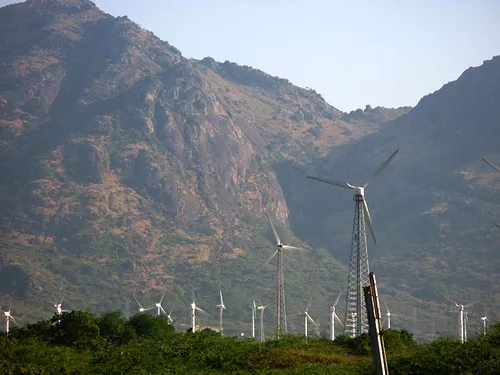
India hopes to meet 50 percent of its energy requirements through renewable sources. Photo by Happy Sleepy CC BY-NC-SA 2.0
The most important issue for India is to grow sustainably while adhering to its international climate commitments and keeping its energy constraints in mind.
By Saon Ray, Indian Council for Research on International Economic Relations
October 29, 2023
There are less than 40 days to go until the Conference of Parties (COP28). This also marks the halfway point for nations to achieve their self-determined emission reduction goals by 2030 and to limit global warming to below 2 degrees Celsius as part of the Paris Agreement signed at COP21.
While most countries agree on the need to reduce emissions and greenhouse gases, there are differences on how this can be achieved.
Developing countries like India have been pointing out the implementation gap from the pre-2020 era or the voluntary pledges under the 2010 Cancun Agreement, which ignored the ambitious targets required from developed countries and shifted a portion of the burden onto developing countries.
The targets not being met by developed countries puts added pressure on developing countries.
At COP 21, ambitious targets for 2030 were announced by Indian Prime Minister Narendra Modi, including 500 gigawatts (GW) of renewable energy capacity and reducing emissions intensity — the volume of emissions per unit of GDP — of the economy by 45 percent as part of its nationally determined contributions.
There were three goals: for cumulative electric power-installed capacity from non-fossil sources to reach 40 percent; reducing emissions intensity by 33 to 35 percent compared to 2005 levels; and the creation of an additional carbon sink of 2.5 to 3 billion tonnes of CO2 equivalent through additional forest and tree cover.
India has also announced its decarbonisation plans and transition to net zero emissions by 2070.
This will depend on the phasing out of coal, which still contributes more than 55 percent to India’s total energy demand. This needs to be accompanied by the use of cleaner coal and technologies that enable energy efficiency. The emissions reduction emerging from this will be comparable to limiting the increase in temperature to 2 degrees.
Instead of coal, India hopes to meet 50 percent of its energy requirements through renewable sources — wind, solar, etc. Incidentally, India has achieved the target of 40 percent of its power capacity from non-fossil fuels well ahead of time.
There are three issues for India. First, it still needs to provide energy to about 9 percent of its population.
Second, phasing out coal is important and needs to be done, but the important domestic conditions that confront India cannot be ignored.
A phaseout has to be done in a just manner. Livelihoods will be impacted, which can have consequences for the rest of the country. India’s coal-rich regions are in the east of the country while renewable energy sources are in the west, which could lead to large-scale westward migration.
Third, India is dependent on energy imports of oil, gas and coal, and depending on the fuel mix in use, there will be implications for the country’s energy security, with new alliances necessary for imports of minerals for batteries or electrolysers for green hydrogen.
The other question is whether greater renewable deployment can meet the technical requirements of grid balance, which means maintaining a balance between production and consumption in an electrical grid and balancing issues like fluctuations or capacity overflow.
The most important issue for India is to grow sustainably while adhering to its international climate commitments and keeping all its energy constraints in mind. This could mean using the principles of energy efficiency in all aspects of energy use, including appliances and in the commercial and residential sectors.
Decarbonisation of industry and the energy system will be key. While this will be easy in certain sectors, it will not be so in sectors such as iron and steel, bricks, etc. For this, access to technology will be necessary. Finance will be absolutely critical in the context of India and other developing countries.
At the same time, countries undertaking the transition should not be getting into debt. It has been suggested that India will need USD$10 trillion for a net-zero transition.
At COP28, higher energy commitments are expected to be put forward.
The first global stocktake process of five years will conclude at COP28 in Dubai. The global stocktake — launched at COP26 in 2021 to assess the progress of the Paris Agreement goals — will also need to identify the sources of finance that will be available to developing countries.
The deliberations will determine how countries respond to the gaps identified in the technical assessment phase (there are three phases of which technical assessment forms the second) and form guidance for future commitments.
For a country adversely affected by climate change, the pathways to low carbon growth include reduction of carbon emissions and increasing energy efficiency.
International cooperation under the aegis of the United Nations Framework Convention on Climate Change and other groups like the G20, particularly the Environment and Sustainability Working Group whose mandate is to enhance cooperation, is needed in order to achieve this.
Whether COP28 will deliver on all of the above remains to be seen.
Subscribe to our newsletter.
Saon Ray is Visiting Professor, Indian Council for Research on International Economic Relations (ICRIER), New Delhi. An economist specialising in industry and international trade issues, her areas of interest include global value chains, technological upgrading of Indian industries, free trade agreements and trade creation effects, technology transfer, foreign direct investment, efficiency and productivity of firms, energy and climate change-related issues.
Originally published under Creative Commons by 360info™.

